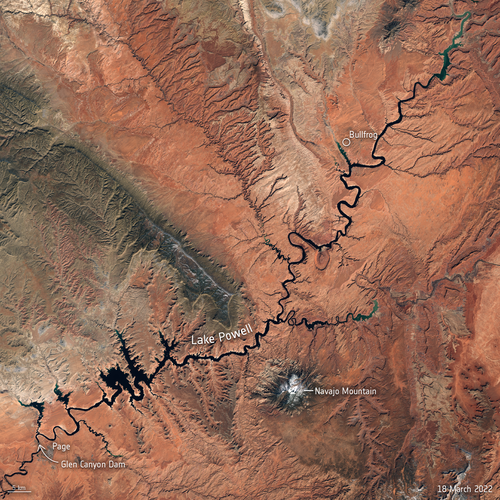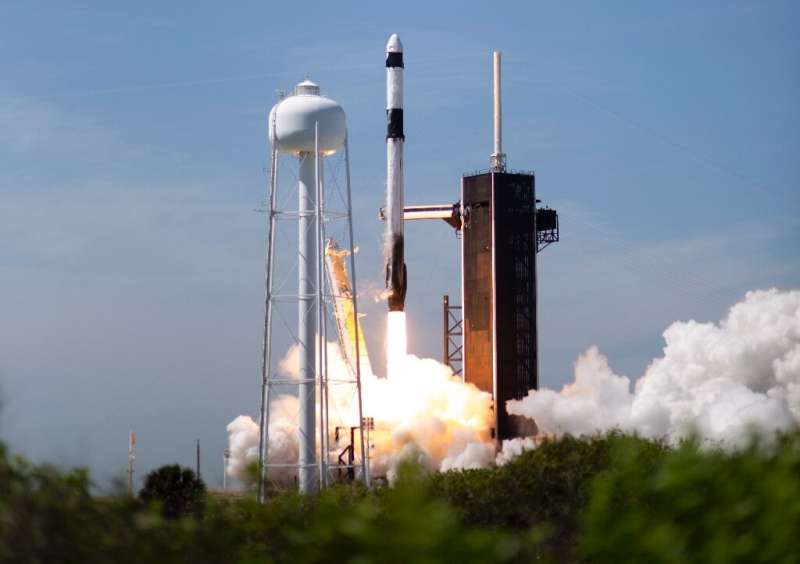
Copernical Team
Dwindling water levels of Lake Powell seen from space

After decades of drought, water levels in Lake Powell, the second-largest humanmade reservoir in the United States, have shrunk to its lowest level since it was created more than 50 years ago, threatening millions of people who rely on its water supply. Satellite images allow us to take a closer look at the dwindling water levels of the lake amidst the climate crisis.
The hunt for the gravitational wave background
 Coalescing supermassive black holes in the centers of merging galaxies fill the universe with low-frequency gravitational waves. Astronomers have been searching for these waves by using large radio telescopes to look for the subtle effect these spacetime ripples have on radio waves emitted by pulsars within our Galaxy.
Now, an international team of scientists has shown that the high-energy
Coalescing supermassive black holes in the centers of merging galaxies fill the universe with low-frequency gravitational waves. Astronomers have been searching for these waves by using large radio telescopes to look for the subtle effect these spacetime ripples have on radio waves emitted by pulsars within our Galaxy.
Now, an international team of scientists has shown that the high-energy CACI completes review for planned 2023 satellite launch
 CACI International Inc (NYSE: CACI) has completed the Critical Design Review (CDR) for its demonstration small satellite program (DemoSat) launch scheduled for early 2023, which is slated to deliver two mission payloads to low earth orbit. CACI and its partner, York Space Systems - a specialized manufacturer of spacecraft and space collection solutions - will demonstrate alternative positioning,
CACI International Inc (NYSE: CACI) has completed the Critical Design Review (CDR) for its demonstration small satellite program (DemoSat) launch scheduled for early 2023, which is slated to deliver two mission payloads to low earth orbit. CACI and its partner, York Space Systems - a specialized manufacturer of spacecraft and space collection solutions - will demonstrate alternative positioning, Astronomers detect galactic space laser
 A powerful radio-wave laser, called a 'megamaser', has been observed by the MeerKAT telescope in South Africa.
The record-breaking find is the most distant megamaser of its kind ever detected, at about five billion light years from Earth.
The light from the megamaser has travelled 58 thousand billion billion (58 followed by 21 zeros) kilometres to Earth.
The discovery was made
A powerful radio-wave laser, called a 'megamaser', has been observed by the MeerKAT telescope in South Africa.
The record-breaking find is the most distant megamaser of its kind ever detected, at about five billion light years from Earth.
The light from the megamaser has travelled 58 thousand billion billion (58 followed by 21 zeros) kilometres to Earth.
The discovery was made Raymond praises Space Force achievements and purpose while noting ongoing threats, challenges
 Using language that was both stark and an urgent call to action, Chief of Space Operations, Gen. John W. "Jay" Raymond, said April 5 that the cornerstone to U.S. security and prosperity is keeping space "accessible, stable, and secure."
And while achieving that goal was once a foregone conclusion, it no longer is. That is why the U.S., its allies and most of all, the United States Space Fo
Using language that was both stark and an urgent call to action, Chief of Space Operations, Gen. John W. "Jay" Raymond, said April 5 that the cornerstone to U.S. security and prosperity is keeping space "accessible, stable, and secure."
And while achieving that goal was once a foregone conclusion, it no longer is. That is why the U.S., its allies and most of all, the United States Space Fo Kendall highlights space's importance, need to 'transform' operations and thinking for the domain
 Presenting a robust case for operating in - and defending - space, Air Force Secretary Frank Kendall said April 5 that "transforming" without delay priorities, practices and spending for the domain is necessary to adequately adapt to a theater that is more volatile yet also increasingly essential to the nation's security and everyday life.
"Space is a warfighting domain now," Kendall blunt
Presenting a robust case for operating in - and defending - space, Air Force Secretary Frank Kendall said April 5 that "transforming" without delay priorities, practices and spending for the domain is necessary to adequately adapt to a theater that is more volatile yet also increasingly essential to the nation's security and everyday life.
"Space is a warfighting domain now," Kendall blunt First all-private mission docks with ISS
 The crew from the first all-private mission to the International Space Station docked with the orbital outpost Saturday morning, a historic moment marked by a ceremonial welcome from astronauts on board.
SpaceX's Crew Dragon Endeavor docked at the ISS at 8:29 a.m. EDT and astronauts entered the orbital outpost at 10:13 a.m.
The docking process was held up for about 45 minutes aft
The crew from the first all-private mission to the International Space Station docked with the orbital outpost Saturday morning, a historic moment marked by a ceremonial welcome from astronauts on board.
SpaceX's Crew Dragon Endeavor docked at the ISS at 8:29 a.m. EDT and astronauts entered the orbital outpost at 10:13 a.m.
The docking process was held up for about 45 minutes aft First private mission reaches International Space Station

The first fully private mission reached the International Space Station early Saturday with a four-member crew from startup company Axiom Space.
NASA has hailed the three-way partnership with Axiom and SpaceX as a key step towards commercializing the region of space known as "Low Earth Orbit," leaving the agency to focus on more ambitious voyages deeper into the cosmos.
A SpaceX Falcon 9 rocket with the Crew Dragon capsule Endeavor docked at 1229 GMT Saturday and the crew entered the space station nearly two hours later, after launching from the Kennedy Space Center in Florida on Friday.
Ten new gravitational waves found in LIGO-Virgo's O3a data
 In the last seven years, scientists at the LIGO-Virgo Collaboration (LVC) have detected 90 gravitational waves signals. Gravitational waves are perturbations in the fabric of spacetime that race outwards from cataclysmic events like the merger of binary black holes (BBH). In observations from the first half of the most recent experimental run, which continued for six months in 2019, the collabor
In the last seven years, scientists at the LIGO-Virgo Collaboration (LVC) have detected 90 gravitational waves signals. Gravitational waves are perturbations in the fabric of spacetime that race outwards from cataclysmic events like the merger of binary black holes (BBH). In observations from the first half of the most recent experimental run, which continued for six months in 2019, the collabor US, Russia Should Cooperate on Leveraging Private Investment for Space Programs - Expert
 Russia and the United States along with other countries should cooperate on leveraging private investment to develop human spaceflight programs as governments struggle with tight budgets, said Greg Autry, professor of space leadership at Arizona State University's Thunderbird School of Global Management.
"I think it is time for Russia to fully embrace the commercial future of space. With i
Russia and the United States along with other countries should cooperate on leveraging private investment to develop human spaceflight programs as governments struggle with tight budgets, said Greg Autry, professor of space leadership at Arizona State University's Thunderbird School of Global Management.
"I think it is time for Russia to fully embrace the commercial future of space. With i 